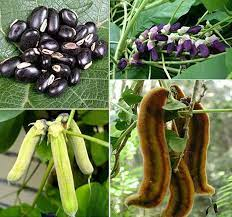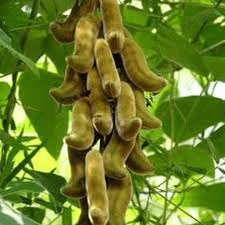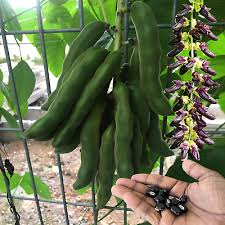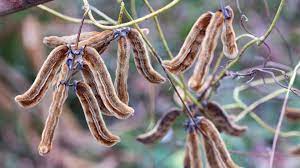Mucuna pruriens, commonly known as Monkey Tamarind or Velvet Bean, is a leguminous plant belonging to the Fabaceae family. Native to tropical regions of Africa and Asia, including India, the plant has a long history of traditional use in Ayurvedic medicine.
The plant is characterized by its climbing vines and compound leaves. The seeds, covered in a dense velvet-like fuzz, are the most notable part of Mucuna pruriens. These seeds are rich in various bioactive compounds, including L-dopa (levodopa), a precursor to the neurotransmitter dopamine.
Mucuna pruriens has gained attention for its potential medicinal properties. In traditional medicine, it has been used for its aphrodisiac, anti-inflammatory, and antioxidant effects. The high content of L-dopa in Mucuna pruriens seeds makes it a natural source of this compound, which is commonly used in the treatment of Parkinson’s disease, a neurodegenerative disorder characterized by dopamine deficiency.
In addition to its neurological effects, Mucuna pruriens has been investigated for its potential role in supporting reproductive health, reducing stress, and improving mood. However, it’s important to note that while Mucuna pruriens shows promise in various areas, scientific research is ongoing, and its efficacy and safety for specific conditions are still being explored.
As with any herbal supplement, it is crucial to consult with a healthcare professional before using Mucuna pruriens, especially if you have existing health conditions or are taking other medications. The dosage and potential interactions with other substances should be carefully considered.
The Botanical Description of Mucuna pruriens
1. Plant Structure: Mucuna pruriens, commonly known as velvet bean, is a leguminous climbing plant. It exhibits a robust growth habit, characterized by twining vines that can reach significant lengths. The plant’s structure is well-adapted for climbing and spreading across various surfaces.
2. Leaves: The leaves of Mucuna pruriens are trifoliate, consisting of three leaflets. These leaflets are ovate to lanceolate in shape and possess a smooth texture. The dark green color of the leaves contributes to the plant’s overall aesthetic appeal.
3. Flowers: The plant produces distinctive flowers that form in drooping clusters. The flowers are typically a vibrant purplish-lilac hue, adding a splash of color to the surroundings. Mucuna pruriens is known for its ornamental value, partly attributed to these visually striking flowers.
4. Pods: Mucuna pruriens develops elongated pods, also referred to as legumes or beans. These pods can vary in size and color, with shades ranging from green to brown. Each pod encases several seeds, and the overall appearance contributes to the plant’s unique botanical identity.
5. Seeds: The seeds of Mucuna pruriens, commonly known as velvet beans, are smooth, shiny, and have a dark coloration. The seeds are a crucial part of the plant, known for their medicinal properties and use in traditional practices.
6. Trichomes: One distinctive feature of Mucuna pruriens is the presence of trichomes on various parts of the plant, particularly on the pods. These trichomes contain a compound that imparts a characteristic itchiness when touched, serving as a defense mechanism against herbivores.
7. Root System: The plant possesses a well-developed root system that anchors it securely to the ground. The roots play a vital role in nutrient absorption and overall plant stability.
8. Growth Conditions: Mucuna pruriens thrives in tropical and subtropical climates. It prefers well-drained soils and is often found in areas with ample sunlight. The plant’s adaptability allows it to grow in a variety of environments, contributing to its widespread distribution.
9. Foliage Density: The foliage of Mucuna pruriens can be dense, especially when the plant is allowed to climb and spread. This dense foliage not only enhances its visual appeal but also provides ecological benefits, such as shade for certain understory species.
10. Hybrid Varieties: Due to its popularity, Mucuna pruriens has been subject to hybridization efforts. Hybrid varieties may exhibit variations in characteristics, including flower color, pod size, and overall plant structure.
The Geographic Distribution of Mucuna pruriens

1. Native Range: Mucuna pruriens is native to tropical regions of Africa, specifically originating from parts of West and Central Africa. In its native habitat, it is known to thrive in both lowland and mountainous areas.
2. Asian Presence: Over time, Mucuna pruriens has been introduced and cultivated in various parts of Asia, including India and Southeast Asian countries. It has adapted well to the climatic conditions of these regions and is often found in both wild and cultivated settings.
3. South American Introduction: The plant has also been introduced to South America, where it has become established in countries such as Brazil. The adaptability of Mucuna pruriens has contributed to its successful naturalization in diverse ecosystems.
4. Global Cultivation: Beyond its native and introduced ranges, Mucuna pruriens has gained popularity as an ornamental and medicinal plant globally. It is cultivated in regions with suitable climates, contributing to its presence in botanical gardens and private collections.
5. Soil Preferences: While adaptable to various soil types, Mucuna pruriens tends to thrive in well-drained, fertile soils. It is often found in areas with a mix of clay, loam, and sandy soils.
6. Altitudinal Range: Mucuna pruriens exhibits a wide altitudinal range, growing from sea level to higher elevations in mountainous regions. This adaptability allows the plant to colonize diverse ecological niches.
7. Human Interventions: Human activities, including cultivation and intentional introduction, have significantly expanded the geographic distribution of Mucuna pruriens. Its economic value, both as a medicinal plant and for soil improvement, has driven intentional introductions.
8. Invasive Potential: In some regions, Mucuna pruriens has displayed invasive tendencies, outcompeting native vegetation. This has led to concerns about its impact on local ecosystems and biodiversity.
9. Climatic Requirements: The plant thrives in tropical and subtropical climates, characterized by warm temperatures and high humidity. It is sensitive to frost and does not tolerate cold conditions well.
10. Ecological Interactions: Mucuna pruriens interacts with various organisms in its habitat. In addition to serving as a host for pollinators attracted to its flowers, the plant’s trichomes act as a deterrent against herbivores, showcasing complex ecological relationships.
11. Conservation Status: While not globally listed as endangered, the introduction of Mucuna pruriens to new regions and its potential invasiveness raise conservation concerns. Efforts are needed to monitor its impact on native ecosystems and promote responsible cultivation.
12. Global Presence: Due to its widespread cultivation and naturalization, Mucuna pruriens can be found in regions with suitable climates across Africa, Asia, South America, and even parts of North America.
The Chemical Composition of Mucuna pruriens
1. L-DOPA Content: One of the key chemical components of Mucuna pruriens is levodopa (L-DOPA), a precursor to dopamine. L-DOPA is of significant interest due to its neuroprotective and neurotransmitter-replenishing properties.
2. Proteins: Mucuna pruriens seeds are rich in proteins, making them a valuable source of plant-based protein. This composition contributes to the plant’s nutritional significance.
3. Tryptamines: The plant contains tryptamine derivatives, including serotonin and 5-hydroxytryptamine. These compounds play essential roles in neurological functions and mood regulation.
4. Alkaloids: Mucuna pruriens contains various alkaloids, with some exhibiting pharmacological activities. Alkaloids contribute to the plant’s bioactive profile.
5. Flavonoids: Flavonoids, known for their antioxidant properties, are present in Mucuna pruriens. These compounds play a role in scavenging free radicals and reducing oxidative stress.
6. Terpenoids: Terpenoids, including saponins and triterpenes, are part of the chemical composition. These compounds contribute to the plant’s overall medicinal potential and may have antimicrobial properties.
7. Phenolic Compounds: Phenolic compounds, such as tannins and phenolic acids, are found in Mucuna pruriens. These compounds have antioxidant properties and may contribute to the plant’s therapeutic effects.
8. Carbohydrates: The seeds of Mucuna pruriens contain carbohydrates, providing an energy source. This composition makes the plant a valuable dietary supplement in certain cultures.
9. Lipids: Lipids, including fatty acids, are present in Mucuna pruriens seeds. While not the primary lipid source, their presence contributes to the overall nutritional content.
10. Fiber: The plant contains dietary fiber, which is beneficial for digestive health. The fiber content adds to the nutritional value of Mucuna pruriens.
11. Minerals: Mucuna pruriens seeds contain various minerals, including iron, zinc, and magnesium. These minerals contribute to the overall nutritional profile of the plant.
12. Essential Oils: Some varieties of Mucuna pruriens may contain essential oils. While the concentrations may vary, these oils can add to the plant’s aromatic properties.
13. Enzymes: Enzymes, such as amylases and proteases, are present in Mucuna pruriens. These enzymes play a role in nutrient metabolism and seed germination.
14. Naphthoquinones: Certain varieties of Mucuna pruriens may contain naphthoquinones, compounds with potential therapeutic properties. However, their concentrations can vary among different plant samples.
15. Antinutritional Factors: Mucuna pruriens also contains antinutritional factors, such as tannins and protease inhibitors. While these compounds may have potential health benefits, their presence in certain concentrations can affect nutrient absorption.
Read Also: List of Diseases Ruminant Animals (Livestock) Get from Feeds and Water
The Medicinal Health Benefits Of Mucuna pruriens (Monkey Tamarind)

1. Neuroprotective Effects: Mucuna pruriens, particularly its L-DOPA content, has been associated with neuroprotective effects. L-DOPA is a precursor to dopamine, a neurotransmitter crucial for brain health.
2. Mood Enhancement: The presence of tryptamines, including serotonin, contributes to mood-enhancing effects. Mucuna pruriens is often used as a natural remedy for supporting mental well-being.
3. Antioxidant Properties: Flavonoids and other antioxidants in Mucuna pruriens contribute to its ability to neutralize free radicals, reducing oxidative stress and supporting overall health.
4. Improved Sleep: Some users report improved sleep patterns and quality after incorporating Mucuna pruriens into their wellness routines. This may be attributed to its impact on neurotransmitters involved in sleep regulation.
5. Libido Enhancement: Mucuna pruriens has a traditional reputation for supporting reproductive health and libido. This effect is linked to its influence on dopamine levels.
6. Anti-Inflammatory Action: Compounds in Mucuna pruriens, including alkaloids, may exhibit anti-inflammatory properties. This makes the plant a consideration for those seeking natural remedies for inflammatory conditions.
7. Muscle Support: Mucuna pruriens is sometimes used by individuals involved in physical activities for its potential benefits in muscle support and recovery.
8. Cognitive Function: The neuroactive compounds in Mucuna pruriens may contribute to enhanced cognitive function. Some studies suggest potential benefits for memory and concentration.
9. Hormonal Balance: The plant’s influence on neurotransmitters extends to hormonal balance, with potential benefits for both men and women.
10. Antimicrobial Properties: Terpenoids and other compounds in Mucuna pruriens may possess antimicrobial properties, contributing to its traditional use in certain cultures for managing infections.
11. Diabetes Management: Some research suggests that Mucuna pruriens may have a role in supporting blood sugar levels, making it of interest in diabetes management.
12. Anticancer Potential: While more research is needed, certain compounds in Mucuna pruriens have shown potential anticancer properties in preliminary studies, making it a subject of ongoing investigation.
13. Anti-Parkinson’s Effects: Due to its L-DOPA content, Mucuna pruriens has been explored for its potential in managing symptoms associated with Parkinson’s disease. However, individuals with Parkinson’s should consult healthcare professionals before use.
14. Anti-Anxiety Effects: The plant’s impact on neurotransmitters may contribute to anti-anxiety effects, providing a natural option for individuals dealing with stress and anxiety.
15. Reproductive Health: Mucuna pruriens has a historical use in traditional medicine for supporting reproductive health in both men and women. Its potential benefits for fertility make it a subject of interest.
16. Anti-Aging Properties: The antioxidant-rich composition of Mucuna pruriens suggests potential anti-aging effects, protecting cells from damage caused by free radicals.
17. Cardiovascular Health: Some studies propose that Mucuna pruriens may have cardiovascular benefits, including the promotion of heart health and maintenance of healthy blood pressure levels.
The Methods of Usage to Achieve the Provided Health Benefits Of Mucuna pruriens (Monkey Tamarind)
1. Dietary Supplements: One common method of using Mucuna pruriens is through dietary supplements. Capsules or powders containing concentrated extracts of the plant, often standardized for L-DOPA content, are available. These supplements are convenient for individuals looking to incorporate Mucuna pruriens into their daily routines.
2. Traditional Infusions: In some cultures, Mucuna pruriens seeds are used to prepare traditional infusions or teas. This method allows for a more natural and holistic consumption of the plant, capturing a broad spectrum of its chemical constituents.
3. Tinctures and Extracts: Alcoholic tinctures and liquid extracts are another popular form of Mucuna pruriens consumption. These concentrated forms provide an efficient way to access the plant’s bioactive compounds.
4. Culinary Uses: In certain regions, Mucuna pruriens seeds are used in culinary practices. Roasted seeds, in particular, are consumed as a snack or incorporated into various dishes. However, proper processing is crucial to neutralize the trichomes and reduce itchiness.
5. Topical Applications: Mucuna pruriens extracts, when properly diluted, can be used topically. This application is often explored for conditions related to skin health, taking advantage of the plant’s potential anti-inflammatory and antioxidant properties.
6. Inhalation: Some individuals use Mucuna pruriens through inhalation methods, such as aromatherapy. Vaporized or diffused forms of the plant may influence mood and promote a sense of relaxation.
7. Combining with Other Herbs: Mucuna pruriens is sometimes used in combination with other herbs to enhance specific health benefits or address particular concerns. Such combinations should be approached with knowledge and caution.
8. Dietary Inclusion: The seeds of Mucuna pruriens can be incorporated into the diet in various ways. Grinding the seeds into a powder and adding it to smoothies, soups, or baked goods is a creative and palatable method.
9. Traditional Brews: Some traditional practices involve brewing Mucuna pruriens seeds into concoctions or herbal brews. This method is often steeped in cultural rituals and may be used for medicinal and ceremonial purposes.
10. External Washes: For certain skin conditions, diluted Mucuna pruriens extracts may be used in external washes. This application allows for targeted skin benefits without the need for internal consumption.
11. Compresses: External compresses using Mucuna pruriens extracts are sometimes applied to specific areas of the body for localized relief. This method can be particularly useful for addressing joint or muscle discomfort.
12. Combination with Carrier Oils: When used topically, Mucuna pruriens extracts can be combined with carrier oils for dilution. This ensures safe and effective application, especially for those with sensitive skin.
The Side Effects Of Using Mucuna pruriens Medicinal Plant
1. Itchiness: The trichomes on Mucuna pruriens pods contain a compound that can cause intense itchiness upon contact. Handling the plant without proper precautions can lead to skin irritation.
2. Nausea and Vomiting: In some individuals, especially when taken in high doses, Mucuna pruriens supplements may cause nausea and vomiting. This emphasizes the importance of following recommended dosages.
3. Digestive Discomfort: Excessive consumption of Mucuna pruriens may lead to digestive discomfort, including bloating, gas, and stomach cramps. Moderation is key to avoiding these side effects.
4. Hypotension: Due to its potential influence on blood pressure, individuals with low blood pressure should exercise caution when using Mucuna pruriens, as it may lead to further lowering of blood pressure levels.
5. Insomnia: In some cases, the stimulating effects of Mucuna pruriens on dopamine levels may interfere with sleep, leading to insomnia. It is advisable to monitor individual responses and adjust usage accordingly.
6. Allergic Reactions: Allergic reactions to Mucuna pruriens are rare but possible. Individuals with known allergies to legumes or plants in the Fabaceae family should exercise caution and seek medical advice.
7. Hallucinations: High doses of Mucuna pruriens, especially in concentrated forms, may lead to hallucinations in sensitive individuals. Adherence to recommended dosages is crucial to prevent such side effects.
8. Interaction with Medications: Mucuna pruriens supplements may interact with certain medications, particularly those affecting dopamine levels or used for neurological conditions. Consultation with healthcare professionals is essential for those on medication.
9. Photosensitivity: Some individuals may experience increased sensitivity to sunlight when using Mucuna pruriens topically. Sun protection measures are recommended to avoid potential skin reactions.
10. Central Nervous System Effects: The plant’s impact on neurotransmitters may result in central nervous system effects, such as drowsiness or changes in alertness. Individuals should avoid activities requiring full attention if experiencing such effects.
11. Potential for Addiction: While rare, there are reports suggesting a potential for addiction or dependence with prolonged and excessive use of Mucuna pruriens. Caution and moderation are advised.
12. Pregnancy and Breastfeeding Concerns: Pregnant or breastfeeding individuals should consult healthcare professionals before using Mucuna pruriens, as its safety during these periods is not well-established.
13. Hormonal Effects: Due to its influence on neurotransmitters, Mucuna pruriens may have hormonal effects. Individuals with hormonal imbalances or those undergoing hormone-related treatments should use the plant with caution.
14. Liver Function: Some compounds in Mucuna pruriens may affect liver function. Individuals with pre-existing liver conditions should monitor their liver health when using the plant.
Read Also: 18 Medicinal Health Benefits Of Kaempferia Galanga (Aromatic Ginger)
The Scientific Research and Studies of Mucuna pruriens

1. Parkinson’s Disease Management: Research has explored the potential of Mucuna pruriens in managing symptoms of Parkinson’s disease, attributed to its L-DOPA content. Studies suggest improvements in motor functions without the side effects associated with synthetic L-DOPA.
2. Antioxidant and Neuroprotective Effects: Scientific investigations have demonstrated the antioxidant properties of Mucuna pruriens, contributing to its neuroprotective effects. These properties may have implications for conditions involving oxidative stress.
3. Reproductive Health: Studies have explored Mucuna pruriens’ impact on reproductive health, indicating potential benefits for sperm quality, testosterone levels, and overall fertility in men.
4. Anti-Inflammatory Properties: Certain compounds in Mucuna pruriens exhibit anti-inflammatory effects, suggesting potential applications in conditions characterized by inflammation, such as arthritis.
5. Mental Health Support: Research has delved into the plant’s influence on neurotransmitters and its potential role in mental health support. Studies indicate effects on mood, anxiety, and cognitive function.
6. Diabetes Management: Preliminary studies suggest that Mucuna pruriens may have a role in supporting blood sugar levels, making it of interest in diabetes management. However, further research is needed.
7. Anticancer Potential: Some compounds found in Mucuna pruriens have shown potential anticancer properties in preclinical studies. This area of research is still in its early stages, requiring more comprehensive investigations.
8. Antimicrobial Activity: Studies have explored the antimicrobial properties of Mucuna pruriens, revealing potential effectiveness against certain pathogens. This adds to its traditional use for managing infections.
The Safety Precautions and Recommendations In Using Mucuna pruriens Medicinal Plant
1. Dosage Moderation: It is crucial to adhere to recommended dosage guidelines when using Mucuna pruriens supplements. Excessive doses may lead to adverse effects, including nausea and vomiting.
2. Allergy Testing: Individuals with known allergies to legumes or plants in the Fabaceae family should conduct allergy testing before using Mucuna pruriens to avoid potential allergic reactions.
3. Consultation with Healthcare Professionals: Those with existing medical conditions or individuals taking medications should consult healthcare professionals before incorporating Mucuna pruriens into their health regimens.
4. Blood Pressure Monitoring: Due to its potential influence on blood pressure, individuals with hypertension or hypotension should monitor their blood pressure regularly when using Mucuna pruriens.
5. Sun Protection Measures: Topical use of Mucuna pruriens may increase sensitivity to sunlight. Users should take appropriate sun protection measures to prevent skin reactions.
6. Caution During Pregnancy and Breastfeeding: Pregnant or breastfeeding individuals should exercise caution and consult healthcare professionals before using Mucuna pruriens, as its safety during these periods is not well-established.
7. Monitoring Liver Function: Individuals with pre-existing liver conditions should monitor their liver function when using Mucuna pruriens, as certain compounds in the plant may affect liver health.
8. Avoiding Prolonged High Doses: Prolonged use of high doses of Mucuna pruriens may have potential side effects. Users should avoid prolonged high doses and prioritize moderation.
9. Attention to Central Nervous System Effects: The plant’s impact on neurotransmitters may result in central nervous system effects. Individuals should exercise caution and avoid activities requiring full attention if experiencing such effects.
10. Caution with Hormonal Imbalances: Due to its potential hormonal effects, individuals with hormonal imbalances or those undergoing hormone-related treatments should use Mucuna pruriens with caution.
11. Monitoring for Potential Addiction: While rare, reports are suggesting a potential for addiction or dependence with prolonged and excessive use of Mucuna pruriens. Users should be mindful of their usage patterns.
12. Gradual Introduction for Sensitivity: Individuals sensitive to dietary changes or new supplements should introduce Mucuna pruriens gradually to monitor individual responses.
FAQs About Mucuna pruriens Medicinal Plant
1. Is Mucuna pruriens safe for regular use?
When used within recommended dosages, Mucuna pruriens is generally considered safe for regular use. However, individual responses may vary, and it’s advisable to consult healthcare professionals, especially for long-term usage.
2. Can Mucuna pruriens be used for Parkinson’s disease?
Research suggests that Mucuna pruriens may have benefits for managing symptoms of Parkinson’s disease due to its L-DOPA content. However, individuals with Parkinson’s should consult healthcare professionals before use.
3. Are there any contraindications for Mucuna pruriens?
Individuals with allergies to legumes or plants in the Fabaceae family should avoid Mucuna pruriens. Additionally, those with certain medical conditions or taking medications should consult healthcare professionals.
4. How does Mucuna pruriens influence mood?
The plant’s tryptamines, including serotonin, may contribute to mood-enhancing effects. Research has explored its impact on neurotransmitters, indicating potential benefits for mental well-being.
5. Can Mucuna pruriens be used topically for skin conditions?
Diluted Mucuna pruriens extracts may be used topically for certain skin conditions, thanks to its potential anti-inflammatory and antioxidant properties. However, proper dilution is crucial to prevent adverse reactions.
6. Does Mucuna pruriens have addictive potential?
While rare, there are reports suggesting a potential for addiction or dependence with prolonged and excessive use of Mucuna pruriens. Users should be mindful of their usage patterns.
7. How does Mucuna pruriens support reproductive health?
Studies suggest potential benefits for sperm quality, testosterone levels, and overall fertility in men. The plant has a traditional use in supporting reproductive health in both men and women.
8. Can Mucuna pruriens be used during pregnancy or breastfeeding?
Pregnant or breastfeeding individuals should exercise caution and consult healthcare professionals before using Mucuna pruriens, as its safety during these periods is not well-established.
9. Are there any interactions between Mucuna pruriens and medications?
Mucuna pruriens supplements may interact with certain medications, particularly those affecting dopamine levels or used for neurological conditions. Consultation with healthcare professionals is essential for those on medication.
10. What precautions should be taken when using Mucuna pruriens topically?
When using Mucuna pruriens topically, proper dilution with carrier oils is essential to prevent skin irritation. Sun protection measures are recommended, as topical use may increase sensitivity to sunlight.
11. Can Mucuna pruriens be used for diabetes management?
Preliminary studies suggest that Mucuna pruriens may have a role in supporting blood sugar levels, making it of interest in diabetes management. However, further research is needed.
12. Is Mucuna pruriens suitable for individuals with liver conditions?
Individuals with pre-existing liver conditions should monitor their liver function when using Mucuna pruriens, as certain compounds in the plant may affect liver health.
13. What is the recommended dosage of Mucuna pruriens?
The recommended dosage of Mucuna pruriens may vary depending on the form of consumption (supplements, teas, tinctures). It is crucial to follow product-specific guidelines and consult healthcare professionals for personalized advice.
Read Also: How to Grow Nettle in Your Garden

